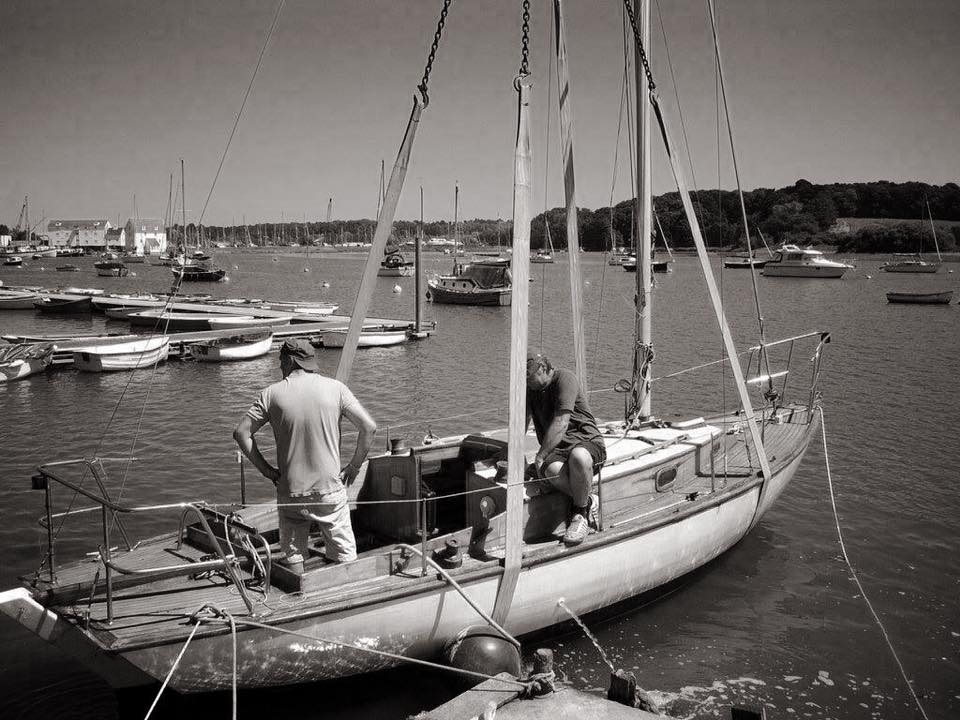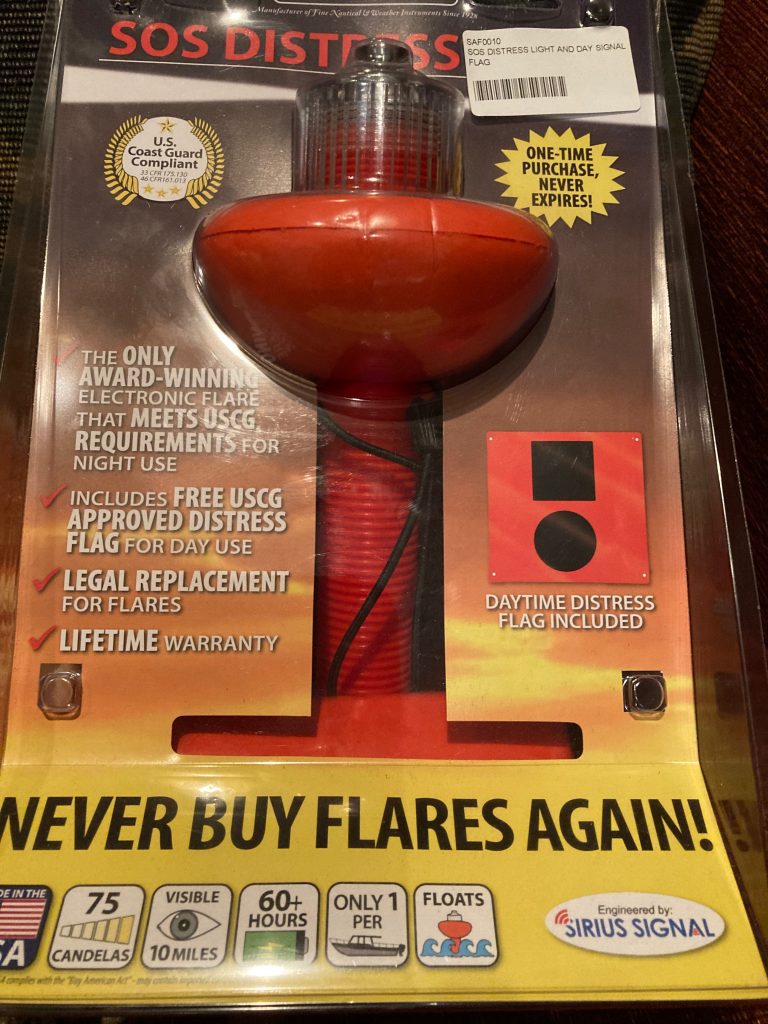The best thing that can happen with any emergency equipment is that it turns out to be a total waste of money. Not because it doesn’t work, but because hopefully you’ll never need it. I’ve always been addicted to the stuff, especially for sailing. I’ve looked longingly at emergency nylon mesh cradles for getting people back on board. You need, you really NEED these if someone goes over the side in the North Sea because as you know from your extensive internet research, the Luftwaffe found more of their pilots survived after a ducking when they were recovered horizontally than if they were dragged out of the water the way you’d do it in a hurry – head up, feet down, along with all their blood, hence the heart attack seconds after they were supposed to be safe onboard. I still haven’t got one of those.
One of the first things I did get however, was a Bell throw-line. That was twenty years ago and it’s been used precisely five times, every one of them in practice. Essentially it’s like a plastic stick grenade except the inside has a coiled line inside instead of explosive, which makes it more acceptable at most yacht clubs. Probably even at Sydney Harbour. The idea is you can throw it further and more accurately than throwing a coil of line, especially into the wind.
But that was then. This year I went slightly higher tech. One of the things that I had instilled into me by my old clients Inmarsat was that mobile phones don’t work offshore. Now, the fact that I don’t go offshore, or in fact out of the treacherous upper reaches of the Deben last year, isn’t the point. I did get marooned, cast-up on an inhospitable shore at the mercy of the elements. It had been a bit of a day.

First, I was late getting out onto the boat. It’s an old, (very) Folkboat, which means it needs 1.3 metres of water underneath it (four foot nine in Brexit money) before you’re going anywhere. In the Deben, this limits your sailing to four hours maximum, or it does from where I’m moored at Martlesham. Still, I thought I had time for a little sail anyway.
I was single-handed, so I motored out to the main channel with the main sail slack and flapping about, then tightened it all up to head downstream. The tide was going out. I just hadn’t appreciated how fast. Off Waldringfield, where you have to stick to the west side of the river, it’s very fast. Too fast to tack through and turn around, but I didn’t know that until I tried.
The plan was put the engine on, tack round, get the main down and motor back while there was still some water. The engine always starts on my boat, so long as the battery is charged. If it turns over, it runs. The only flaw in this plan was that it takes about two minutes to do it. You have to make sure it’s in neutral, kneel down, unlatch the hatch, pull it up, latch it up so it doesn’t fall on your head. I hate things hitting my head. Really hate it.
Next you pull the valve lever up, hold it up while you push the starter button then release the lever, unlatch the hatch, close it and latch it down again. Obviously you can’t steer or do anything else while you’re doing all this. Nor see where you’re going.
Where I was going, or where the five knot current was taking me, wasn’t through the anchorage, it turned out, but into the mooring line of an anchored-up Essex gin palace about five times bigger than my boat. The first time I was really aware of its existence was when I got its bow-sprit in my ear. No matter. We can just push off and drift down with the current. Except we can’t, because the gin palace’s anchor warp (oh, alright, rope then…) was happily wedged between my rudder and the stern of my boat. Because I hadn’t put the bottom rudder plate back on when I replaced the rudder. Because I hadn’t, that’s all.
The Harbour Master came out in a dinghy before I actualised my plan to cut the gin palace’s mooring loose. He tried to pull my boat clear but it wasn’t having any of it until he went back and came out with a boat with a bigger engine. I started-up again, free of the big plastic boat and departed with a cheery wave with which apparently they’re unfamiliar in the nautical parts of Essex.
I hammered back up the Deben to where the creek reaches West to Martlesham and home. And stupidly cut the corner. And stupidly came to a halt, stuck in the mud. I put it in reverse and shifted a little bit backwards. Just enough for my fibreglass dinghy to keep coming forward and drop its tow line around my propellor, which it wound around until the dinghy was dragged under and into the prop. Which happily started chewing it up until it turned over. I reached for my old sailing knife then, convinced idiotically that the dinghy would pull the yacht down with it.
The knife worked very well indeed, I’m pleased to say. The dinghy sank under the Folkboat, in all of by now three feet of water. With the tide running out the Folkboat settled over the dinghy. And cracked it in half as four tons of wood and lead keel did what Mrs Shearn’s Physics O Level lessons predicted it would.
Just static
I thought the best thing to do would be to phone Devoted Partner, except my phone was on the driver’s seat of my car. I had a handheld VHF radio though (obviously…) so I put out a PAN call. No answer. Nothing. I tried to call-up the Coastguard by name, but still nothing. Just static. I was close enough to the river bank, about thirty metres, to shout to a walker. Could he call Devoted Partner whose number was luckily in my notebook which I did have with me, so she’d know I wasn’t lost at sea, just going to be quite late. Like ten hours late, by the time the tide had come back again and floated me off this mudbank.
He did. I didn’t know what was happening now, because he’d walked away on his walk. It was August, but I had some water onboard and some old biscuits in a tin. No Swallows And Amazons pemmican, but you can’t have everything. My biggest concern, apart from no dinghy any more, was I didn’t have a book nor even Radio4, and although we were aground, you can’t walk on Deben mud. You’d drown, very unpleasantly. All I had to do was sit there.
I set an anchor fore and aft, then busied myself recovering one of them and throwing it out as far as I could towards the bank to stop the boat falling over down the slope of the river bank in case it didn’t float when the water came back, just filled up and sank. By now the idea of a final insurance claim seemed quite attractive.
About an hour went by. The boat wasn’t going to fall over. It was warm enough. Just a bit boring. But that all changed when the flourescent jackets turned up on the bank. They obviously, from all the pointing going on, wanted to talk to me, all eight of them, but they were at Kyson’s Point, about 100 metres away and I couldn’t hear them. They got someone to get a rowing boat out of his boathouse and row them out to me. It was the Coastguard Mud Rescue Team.
I pointed out, through our Covid masks, that I had no intention of going in the mud, so I didn’t really need rescuing. They said they had concerns about my emotional health. I didn’t really know what to say about that. There were too many of them in the rowing boat to take me off, so the man whose boat it was rowed them back to the bank, dropped two of them off then had to row back for me. He just lived there. Amazingly, the Coastguard Mud Rescue team doesn’t have a dinghy.
As we walked back to my car and my phone I found out what had happened. The walker had phoned Devoted Partner who being a brick dutifully called the boatyard. Who told her they couldn’t do anything because their boat needed water as well as mine did, and why didn’t she phone the Coastguard? They were joking, but being a very nice, caring woman as well as Devoted Partner and a brick, that’s exactly what she did.
I went home, thanked her and drove back the next day. The boatyard gave me a lift down in their work tug. The Folkboat was fine, floating at anchor. My fibreglass dinghy wasn’t. We managed, somehow, to tow it back the mile up Martlesham Creek but by the time we got to my mooring it was pretty much in two halves. I bought a brand new, much nicer inflatable dinghy the next week, long overdue, but that isn’t the point of this tale.
Attention Seeking
I felt I needed a reliable way of attracting attention in future, preferably without my mental health being called into question. The Coastguard said their transmitter was out, hence no reply. Traditionally, you use flares. Not the velvet ones they used to advertise in New Musical Express, but the pyrotechnic kind, either quite exciting parachute flares, which shoot up into the sky and shine a red light for about 10 seconds, or handheld red flares which are great for blinding you, incinerating your hand and setting fire to your boat. They don’t burn for very long and they have a shelf-life. The end of that is when your problems really start, because it’s completely unclear to me where you can get rid of them safely. You used to drop them off at the Coastguard shed, but that’s stopped years ago.
But this thing solves both those problems. It’s battery powered. One twist of the switch and it burns not for ten seconds or so, but for 60 hours. Even groovier, it doesn’t use flash, it flashes S-O-S! How cool is that? It never goes out of date. It won’t burn your hand, your boat or your eyeballs out, although if you actually are stupid enough to look directly at it in the yard when you’re testing it one dark night as I obviously am, expect to still see its short-short-short-long-long-long-short-short-short ghost image burned on your retinae for the next ten minutes or so.
Even better, because good kit is never cheap, I got this one from someone who bought it last year and never used it, so half price. Like all the other safety kit I’ve ever bought, I hope it’ll turn out to be a total waste of money.



